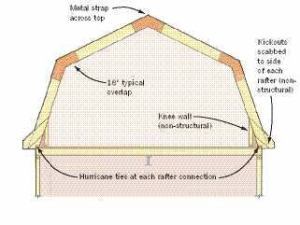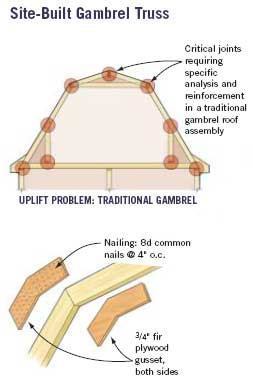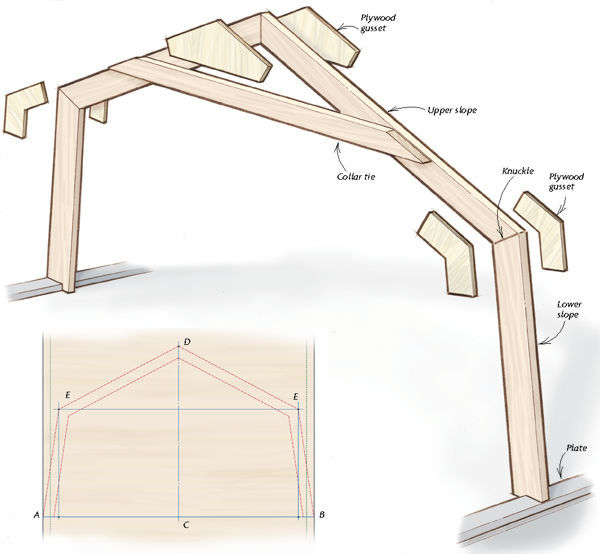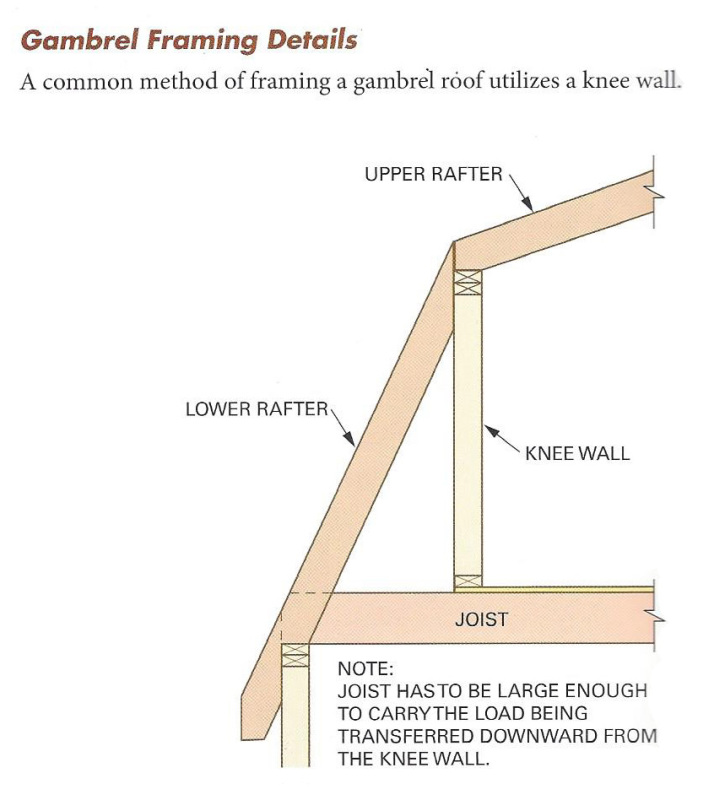medeek
Structural
- Mar 16, 2013
- 1,104
This one is looking to be an interesting project. The client wants to stick build the roof in a similar fashion to the method detailed by Andrew DiGiammo in the Journal of Light Construction:
The method is similar to a site built truss in a lot of ways using 3/4" plywood as gusset plates as shown below:


I haven't got into all of the details yet but just poking around the internet I've found some interesting articles etc...
I will provide further structural details as I progress but for now I'm just wondering if anyone else has looked at this type of system before?
I will probably put this into Risa3D to determine my moments, axial and shear of the members at the joints. This is a very similar problem to analyzing a site built truss. Here are some basic assumptions and initial thoughts:
1.) The floor joist will be loaded in tension, preventing the frame from speading its legs, in essence the bottom chord of the truss. Check this member for combined tension and bending due to floor loading.
2.) The connection at the floor joist (I Joist) and the bottom of the frame will be assumed to be pin jointed with attention to the uplift and tension at this joint. I'm thinking a sill plate that the 2x12 or 2x10 lower rafter is notched into might provide a nice positive connection for the outward thrust of the roof. I'm still thinking about uplift and what ties to use at this location.
3.) 3/4" plywood gusset plates will be at three locations. Tension and Moments at these locations will control the design of the gusset plates and fasteners. The debate of single shear vs. double shear nailing continues. The large gusset plates will create rigid joints at these locations.
4.) Check the the upper and lower rafters in combined compression and bending.
5.) The client will probably install a knee wall and a collar tie, how does this affect the analysis.
6.) The floor joist will be supported at approx. mid span by a bearing wall on the first floor.
7.) Need to look into wind loads on gambrel shaped roofs, this one is new for me.
Just a few things to get started with, I'm sure there will be other questions, assumptions and issues with this design.
A confused student is a good student.
Nathaniel P. Wilkerson, PE
The method is similar to a site built truss in a lot of ways using 3/4" plywood as gusset plates as shown below:


I haven't got into all of the details yet but just poking around the internet I've found some interesting articles etc...
I will provide further structural details as I progress but for now I'm just wondering if anyone else has looked at this type of system before?
I will probably put this into Risa3D to determine my moments, axial and shear of the members at the joints. This is a very similar problem to analyzing a site built truss. Here are some basic assumptions and initial thoughts:
1.) The floor joist will be loaded in tension, preventing the frame from speading its legs, in essence the bottom chord of the truss. Check this member for combined tension and bending due to floor loading.
2.) The connection at the floor joist (I Joist) and the bottom of the frame will be assumed to be pin jointed with attention to the uplift and tension at this joint. I'm thinking a sill plate that the 2x12 or 2x10 lower rafter is notched into might provide a nice positive connection for the outward thrust of the roof. I'm still thinking about uplift and what ties to use at this location.
3.) 3/4" plywood gusset plates will be at three locations. Tension and Moments at these locations will control the design of the gusset plates and fasteners. The debate of single shear vs. double shear nailing continues. The large gusset plates will create rigid joints at these locations.
4.) Check the the upper and lower rafters in combined compression and bending.
5.) The client will probably install a knee wall and a collar tie, how does this affect the analysis.
6.) The floor joist will be supported at approx. mid span by a bearing wall on the first floor.
7.) Need to look into wind loads on gambrel shaped roofs, this one is new for me.
Just a few things to get started with, I'm sure there will be other questions, assumptions and issues with this design.
A confused student is a good student.
Nathaniel P. Wilkerson, PE


